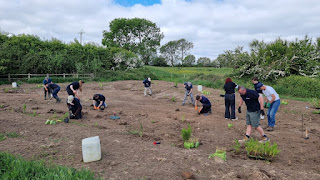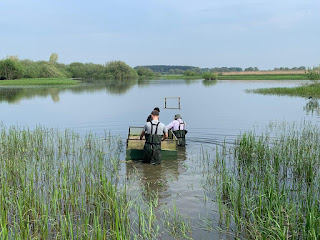Well, June feels like an awful long time ago now, and how busy we have been reflects the absence of posts to this account, with normal service set to resume, but we've been rather preoccupied doing our very best to help increase the population of Corncrakes in England...
After months of hard work on the ground we’re delighted to be able to share the news that our team, comprising the Friends of the LDV,
Carstairs Countryside Trust and Natural England, have teamed up with Deepdale
Conservation Trust in Norfolk, in an attempt to bring Corncrakes back into the soundscape
of the Ings wonderful hay meadows. Whilst the reserve here is probably the most
reliable place in England for attracting Corncrakes, with one or two singing
males recorded most years (and larger numbers/potential breeding has occurred
in some of those years), this project is seeking to build and reinforce numbers
to a self-sustaining population of up to 50 singing males.
A captive breeding population of chicks taken from the
Scottish population have been held by Deepdale Conservation Trust over the summer, where expert aviculturists paired the birds and allowed them to parent-rear their
chicks. At 14 days old these chicks were then transferred during the night to
the LDV’s pre-release pens, where they remained until 34-35 days old, allowing
them to fix on the night sky and enable them to hopefully know the LDV as
‘home’. Once released these birds will have hopefully migrated as normal to Africa for the winter,
but the hope is that some will then return to the Ings next year to breed
and mix with wild birds, giving the population a real boost.

Back in April following the news of the project, our team only had three weeks to build the pre-release
pens, which would soon be home to the Corncrake chicks. The pens needed to be predator proof (down to the size of a weasel, which can
fit through a finger sized hole), over-wired and completely safe for the birds
to avoid any welfare issues or injuries. This took a monumental effort by our
small team of staff and willing volunteers, who stepped up and put in long
hours, assisted by the young people and staff of Ad Astra who produced the
frames, as well as our corporate groups who leant a hand – so a fantastic team
effort, and without it we simply could not have got the job done and the pens
ready in time.

Furthermore, ahead of the first birds that arrived in late May
we needed to have the individual pens (16 in total) vegetated with nettles,
meadow sweet, yellow flag iris and other vegetation favoured by Corncrakes to
give them enough cover to thrive. So there followed plenty of transplanting,
watering, fertilising and ‘gardening’ by the team before the first brood of
five arrived, just as the 20,000 staple went in!

Once the chicks were ready to leave their breeding pens in
Norfolk (aged 14 days old) they were driven overnight to our pre-release pens in
the Lower Derwent Valley and were kept together as broods in separate pens. From
then on they spent the next three weeks in these pens, being fed
twice a day on a mixture of specialist pellets and mealworms which have been
fed on a nutrient-rich diet. Over this three-week period the diet was altered as
the chicks grew in age to prepare them for a more natural diet out in the wild,
before they were released following a veterinarian health check, when they were also ringed, colour-ringed, DNA swabbed and (for a small sample of birds),
fitted with tracking tags. Attaching this small tag allowed us to monitor the
birds post-release and see how they were using the area and habitat around the
reserve, all helping to provide valuable information for managing the site
going forward to further help these birds. The tags indicated that
the birds were staying an additional week to 10 days, and departing on the
mean average date we would expect from wild Scottish birds. All that is left
now is to hope that some of these birds return next spring, which is when we will need
your help from mid-April, in listening out for and sending us records of
calling individuals around the reserve, so please do get in touch and let us
know if you hear one.



Whilst this project is far from over, we are at the end of our first year of releases, which wouldn’t have been possible
without the help of all of our partners and supporters, so huge thanks must go
to the Friends of LDV, Carstairs Countryside Trust, Natural England, Deepdale
Conservation Trust, Ad Astra, Drax and our fantastic volunteer team and
corporate volunteer network, as well as to all of you who have supported the
Friends via card sales, logs, talks and making donations – you have helped in
our efforts to bring Corncrakes back to the Lower Derwent Valley, to Yorkshire
and to England.




































